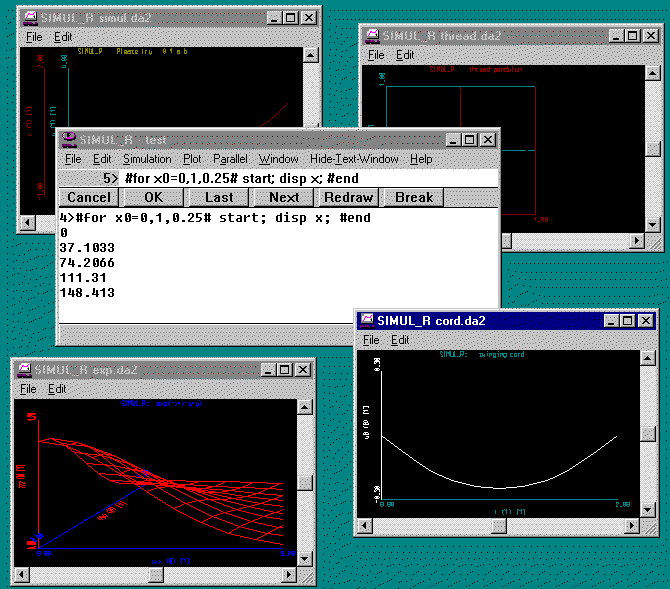

SIMUL_R is a simulation system for continuous and discrete dynamical systems.
SIMUL_R supports modelling, analysing and documenting complex systems.
SIMUL_R offers a great area of graphic commands.
SIMUL_R is a compiling language: fast simulations.
SIMUL_R is based on the programming language C.
SIMUL_R is open: extendible by new commands, algorithms.
Specials: data base and dialogue interface
The Model ...
A SIMUL_R-program contains one or more continuous models (in equation notation). The SIMUL_R-language, fitting to C's syntax and to the CSSL Standard, offers a big library of macro commands. By that even complex systems can be formulated readable and checkable.
An own macro library offers among others special commands for controling applications.
A special solver allows for the easy-to-use solving of implicite problems.
Units can be assigned to simulation variables. These units are checked and, if necessary, transformed.
... is created, ...
Models can be as well created graphically, using the tool SIMDRAW.
... translated, ...
The model is translated into C. This gives the possibility to include own programs into the simulation for special applications.
... in a simulation environment ...
The translated model can be simulated in a strong runtime-(command-)interpreter.
A menu- and mouse-driven desktop (under MS-Windows and X-Windows) is available, too.
... analysed and ...
The runtime-interpreter supports commands for startig one or more models parallel and/or sequentially, for displaying and setting model variables. Herein arbitrary expressions can be used.
System analysis is made easy by loops (while, for, loop), conditional (if, ifdef) and subroutine commands (call). By this complex analysis tasks can be performed in the runtime-interpreter without changes to the model.
Very important are the commands for working with table functions (storing, loading, recording of variables during a simulation run).
All data values (variable, simulation data, drawing) are available as well in the ASCII format and so can be exchanged between SIMUL_R and other programs.
Last not least SIMUL_R contains commands for zero search, optimization, computation of the Jacobian matrix (linearization), steady-state and Eigen value analysis, as well as extension possibilities for user specific commands.
... documented.
During the development of SIMUL_R special attension has been paid to graphical presentation of data.
Of each simulation data values plots over time or other simulation languages can be drawn in any scale, in freely definable height and with arbitrary numbering.
Beside 3D-plots, parameter and isoline plots there are as well methods for presenting moving curves (e.g. point with tangent, moving of whole curves), especially for displaying results of partial differential equations.
Drivers for plotters and printer (under MS-Windows for all Windows-drivers) are available as well.
SIMUL_R is available for Windows-2000/NT/95/98, OS/2, several workstations under Unix, Linux, parallel computers, vector computers and Transputers.
Special Features:
Database and dialogue interface (SIMUL_R+)
Special runtime commands allow for the access to data bases (e.g. Oracle, ODBC). The database tables are accessed using flexible hierarchical struktures.
Using interpreter commands dialogue boxes, menustructures and tollbars, and therefore flexible desktops are created.
Realtime and parallel simulation
Open interfaces allow for the inclusion of hardware-in-the-loop-interfaces for realtime simulation as well as the parallel simulation of submodels.
Partial differential equations
Partial differential equations are modelled using model macros. Optionally boundary conditions can be specified. Available methods are the line method and Crank-Nicholson's. PDEs are seamlessly combined with ordinary differential equations.
Use the info-form to request further information.
| Home |
Copyright Simutech 2002
Mail to webmaster |